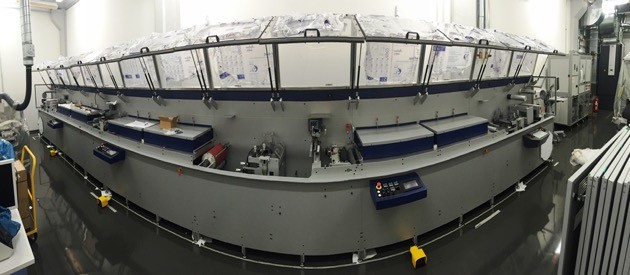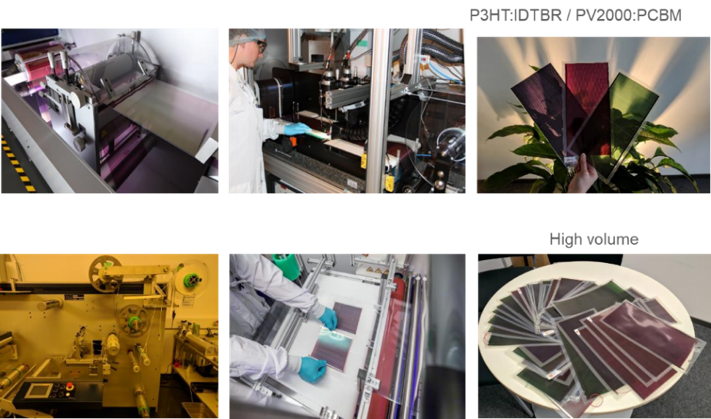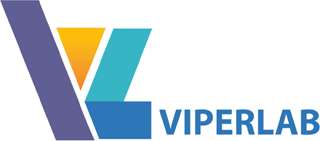- An highly advanced r2r-coating-line for the upscaling of solution processed semiconductor based solar cells for the upscaling into modules
- Preparation and characterization of thin solution processed films, development of new coating and printing processes and Electrode materials
- Scaling of printed cell layers to industrially relevant sizes (approx. 30 x 30 cm²)
The TA facility r2r-coating-line is a highly advanced printing facility for the upscaling of solution processed semiconductor based solar cells into modules. The r2r-coating-line can perform advanced coating trials from small scale (~10cm2) to large scale (~10m2). Roll-to-roll laser ablation capabilities can be utilized to turn upscaled layer into modules. In addition, the facility has all necessary backend capabilities for bussing, packaging, contacting and characterization of printed modules.
Description of the infrastructure
R2R-Coating-Line allow the production of larger quantities (litre scale) of inks for roll-to-roll printing. The solar modules are manufactured by combining various printing techniques with laser structuring processes.
- Preparation and characterization of thin solution processed films.
- Evaluation of existing and development of new coating and printing processes for solution processed solar cells and solar modules.
- Analysis and characterization of single layers, multilayers, solar cells and modules.
- Development of Electrode materials
- Development of structuring procedures and interconnection techniques
- Scaling of printed cell layers to industrially relevant sizes (approx. 30 x 30 cm²)
- Construction of a roll-to-roll pilot plant for the production of printed solar modules in an inline process and development of coordinated process steps.
- Lifetime of Solution processed electronics: encapsulation processes and investigations of ageing processes.
The three (3) head roll to roll line for coating solar modules (r2r-Coating-Line) has been taken into operation and state of the art printed (organic) modules have been demonstrated on that line. Recently, we have equipped the line with extended ventilation power and now can operate the whole line up to a width of 300 mm under humidity levels of less than 15 % at controlled temperatures.
The coating line is fitted with 3 individual coating stations that can be equipped with a variety of coating or printing heads at variable width up to 300mm. Each coating station is followed by a drying tunnel with 2m in length consisting of two individual drying stages that allow for individual drying profiles. The unwind has a web-cleaning and a Corona treatment station. Each coating stage has its individual registration unit allowing registration at less than 100µm resolution. The line can be operated at up to 10m/min web speed.
For processing of modules, the line has roll-to-roll laser processing capabilities with ns- and fs-lasers with galvo-heads allowing for laser ablation of P1/P2/P3 lines to generate module interconnects with ~10µm resolution. Front-end (web splicing, winding, slitting) capabilities as well as back-end (packaging, bussing, connector application, laser-cutting) processes are available to make fully operational and packaged modules.
The r2r-coating line has been operational since 2018. It has produced and characterized hundreds of meters of organic photovoltaic modules.
Table 1 Materials processed on r2r-Coating-Line
|
Material |
Ink and Film Properties |
Applications |
|
Organic Semiconductors |
Layer thickness from 5 – 500 nm, ink viscosity from 1 – 500 mPas, from all organic solvents. |
Photovoltaics, energy harvesting, light emission, sensors. |
|
Nanoparticles and colloidal nanocrystals: ZnO, SnO2, TiO2, AZO, WO3, MoO3, NiO. |
layer thickness from 20 – 200 nm. |
Charge extraction/injection layers, dielectric mirrors. |
|
Ag Nanowires. |
conductivity from 6 Ohm/sq to 500 Ohm/sq. |
Photovoltaics, OLEDs, sensing, touch screens. |
|
Barriers and thin film encapsulation. |
Lamination or coating + curing. |
Device protection |
|
Adhesives. |
Curing by heat or UV light. |
Device packaging |

Figure 1 Three (3)-head roll-to-roll coating line for solar modules

Figure 2 Details of the coating equipment, laser patterning for interconnects and modules produced by the line
Services currently offered by the infrastructure
The r2r-coating-line provides large area coating and process development, module design, interconnect development packaging and finishing for solution processed solar modules. The r2r-coating line takes small scale processes proven for individual cells (typically processed on glass), transfers these processes to flexible substrates and industrially relevant solvent systems, upscales the processes to larger substrate sizes, designs and optimizes modules based on these processes, packages and characterizes the modules.
Modality of access under this proposal
- Unit of access (how many user visits are expected): 10 users; before any access, preparatory planning by telco and/or exchanges of information is to be included, as well as afterwards joint data analysis and conclusions are to be counted
- Remarks on integration of users into the scheduling of the RI: IMEC in agreement with the user will plan the visit and use of tools at the facility, whereby the scheduling will be in accordance with the priority needs of IMEC.
- Access costs: combination of unit costs and actual costs, as it depends on the type of equipment to be used and the need to fully dedicate its use to the visit or shared use with JUELICH team members can be arranged.
Support offered under this proposal
As part of Viperlab, virtual or on-site access to the r2r-coating-line is made available on the basis of operating days for processing. The user defines the reference material system as well as the basic process to make reference cells. The r2r-coating-line team will perform the upscaling, coating trials and module development. Special materials in relevant quantities need to be provided by the user. In Viperlab, standard processes as well as process development are offered. Process development requires higher on-site support by scientists than standard processes that have already been developed. Processing is performed on the r2r-coating-line which is operated by a team of technicians and scientists. The users have the opportunity to join the processing on-site to make observations during the scheduled process run.
Specific services offered by the r2r-coating-line:
- Design of inks with industrially relevant solvent systems for large area coating.
- Development of stable, reproducible and scalable crystallization strategies and processes.
- Inline laser patterning.
- Inline packaging of modules, incl. automated bus bar connections, laser cutting, contacting.
- Module characterization.
Typical sizes for coating trials are between 10-100meters on a web width of 30cm. Typical module sizes are 150x150mm2 up to 150x300mm2.
For an operating day of the r2r-coating-line the support by technicians, scientists, power, small consumables, are covered as part of the access cost. Materials for the coating trials must be provided or paid for by the user.
Partecipation in others relevant Research Projects or activities connected to VIPERLAB
Contact the infrastructure
Expertise
VIPERLAB Infrastructure's contact




